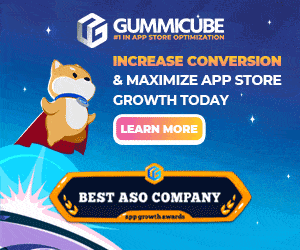Various factors influence the search ranking of apps in the App Store. Search engine ranking, or search rank, is the position of a particular web page or app in the results for a specific search term. Among the various factors influencing search rankings, recently, there has been particular attention on the information regarding the rankings determined by the Apple search algorithm and which factors specifically, affect those rankings.
Source: Wall Street Journal
The figure below is an excerpt from an article published in the Wall Street Journal in 2019, which reveals some aspects of the algorithm Apple uses to determine App Store search rankings.
The article specifically mentions that there are a total of 42 factors that determine App Store search rankings, with the following four factors being the most influential:
- Downloads
- Ratings
- Relevance
- User behavior
The most impactful factor, according to Apple, for search ranking is “user behavior.” The article states that if users frequently select or download an app after searching for a specific keyword, it positively affects that app’s search ranking.
However, it is, of course, prohibited to manipulate the search algorithm deliberately. Such manipulation can lead to risks such as lower rankings or your app being removed from the store. Naturally, we do not recommend using these tactics at all.
So, what should be done? We believe one of the answers is to “conduct A/B tests at the keyword level and increase the conversion rate (CR) of users coming from those keywords.” In other words, improving CR after users search for a keyword is synonymous with enhancing the “user behavior” mentioned above. Consequently, appropriately changing screenshots becomes one of the most crucial factors.
In summary, if the “CR for specific keywords” increases, the search results will also improve.
As we have seen so far, it is essential to first accurately understand the App Store search algorithm. Developers and marketers need to create marketing strategies that are reverse-engineered from the algorithm to achieve effective organic acquisition through App Store search rankings.
About keyword CR
Earlier, we mentioned that in the App Store search algorithm, when there is an increase in “CR for specific keywords” leads to an improvement in search results. Let’s delve into this in more detail.
Please take a look at the section enclosed in the red box in the above figure.
The algorithm for keyword CR works as follows:
Let’s say a user searches for “sports games” and presses the “Get” button for a particular app on the search results screen. If this action is performed frequently, this leads to the app being downloaded from the keyword search results screen, thereby increasing the keyword CVR and improving the search ranking.
Therefore, in the next section, we will discuss how we have been providing “A/B testing methods that can address keyword CVR” through our V.O.X service and the agency services we offer for many years. For example, in one instance, we will introduce an example of A/B testing using the features of our V.O.X service below.
A/B testing of screenshots with V.O.X
Let’s discuss the A/B testing feature for screenshots in V.O.X. Please take a look at the figure below.

Using Apple Search Ads (ASA) and Custom Product Pages (CPP), you can conduct A/B tests on a keyword basis. This allows you to aim for the maximum effect in improving the search ranking according to the App Store algorithm.
Specifically, as shown in the left figure, when searching for the keyword “travel guide,” AwayFinder is subject to A/B testing among the displayed results. Screenshot A includes a yellowish tone and a map, while screenshot B features a different background and content. These different versions are then A/B tested using Apple Search Ads.
During this process, based on years of experience, we use algorithms to analyze within V.O.X and agency services. For example, the detailed report from V.O.X’s automatic distribution of Apple Search Ads (right figure) evaluates results such as the ad spend and CTVR (conversion rate from impressions to installs). CTVR is an indicator that evaluates how many installs occurred from the number of impressions, not clicks. V.O.X adopts A/B testing methods that prioritize CTVR.
This is because looking at CVR (conversion rate from clicks to installs) alone misses the value of impressions, leading to inaccurate information. By adopting CTVR, we evaluate test results from a perspective that considers the value of impressions, different from CVR.
Additionally, using CPPs (Custom Product Pages), you can customize product pages to freely change screenshots A and B. This allows for A/B testing on a keyword basis.
In summary, the ideal A/B testing of screenshots involves using Apple Search Ads and CPP to conduct tests based on keywords and evaluate the value of impressions through CTVR. This enables the selection of more effective screenshots compared to the CVR evaluation of App Store Connect. (For details on V.O.X’s A/B testing features, click here.)
Comprehensiveness of the App Store Search algorithm and its scope
So far, we have mainly looked at keyword CR (A/B testing of screenshots) as an example. While keyword CR is an important factor, it is essential to understand that there are multiple algorithms, and all other elements need to be fulfilled. Based on our experience, even if keyword CR increases, it will not have a significant impact unless other factors are also comprehensively met. It requires a holistic approach.
Of course, a lot of expertise is required. We pride ourselves on having the most extensive track record in Japan for improving keyword CR and screenshots.
Whether the direct keywords are included, or relevant keywords are comprehensively covered, or Apple Search Ads (ASA) are optimally delivered—all these factors contribute to positively influencing search rankings. As a result, we can expect a significant increase in organic traffic. It is also important to note that in-app performance metrics such as DAU (Daily Active Users) and MAU (Monthly Active Users) are highly influential factors. We believe that a truly comprehensive ASO service covers all these aspects.
Next, let’s look at specific examples of comprehensiveness.
Direct keyword targeting
When users search for specific keywords, apps that include those keywords in the title or subtitle are prioritized in the search results.
Indirect keyword targeting
In addition to direct keywords, search results also consider indirect relevance. This means that keywords related to the user’s search, but not directly included, are also considered. For example, apps containing similar or related keywords have a higher chance of appearing in search results. This topic will be covered in another article.
Keyword Conversion rate (CR)
If users frequently install or download an app after searching for a specific keyword, that app’s search ranking improves. In other words, the higher the app’s conversion rate for a keyword, the better its ranking in search results.
Installs
The number of downloads also affects search rankings. Apps with higher download counts rank higher in search results because they are considered more popular and reliable. We recommend using Apple Search Ads, as it is the most influential ad channel for iOS, to secure downloads.
Ratings
An app’s rating also influences its search ranking. Apps with higher ratings rank higher in search results, as positive user reviews indicate quality and value.
These factors combined determine the search rankings in the App Store. Understanding this mechanism and continuously optimizing your app based on the algorithm are crucial to ensure your app is consistently discovered by users.
V.O.X covers the following areas:
- A/B Testing Functionality
- Automatic ASA Management
- ASO Creation Tools
Conduct A/B Tests for keywords:
Begin by performing A/B tests under keywords to identify effective strategies. This is a straightforward approach to improve download rates. V.O.X supports this process by providing evidence and ASA at the keyword level.
Optimize user behavior:
Continuous A/B testing at the keyword level is effective in improving user behavior. Using V.O.X to conduct ongoing A/B tests can help improve rankings.
Leverage V.O.X coverage:
V.O.X encompasses the elements derived from the algorithm, allowing keyword-level optimization and approaching ideal search rankings.
By combining these steps, V.O.X can enhance user behavior and improve search rankings. Utilizing various V.O.X features, including A/B testing, helps achieve ideal search rankings.
Understanding the strategic approach based on the algorithm (V.O.X) enables more effective app marketing.
Summary
✅ To improve app search rankings, it is necessary to develop marketing strategies based on the algorithm;
✅ Approaches to enhance and optimize “user behavior” are effective in achieving ideal app search rankings;
✅ Specifically, conducting A/B tests under keywords to identify effective strategies is important;
✅ Continuous optimization based on the algorithm is crucial for ensuring your app is consistently discovered by users;
✅ ASO Measures Textbook Editorial Department.
















